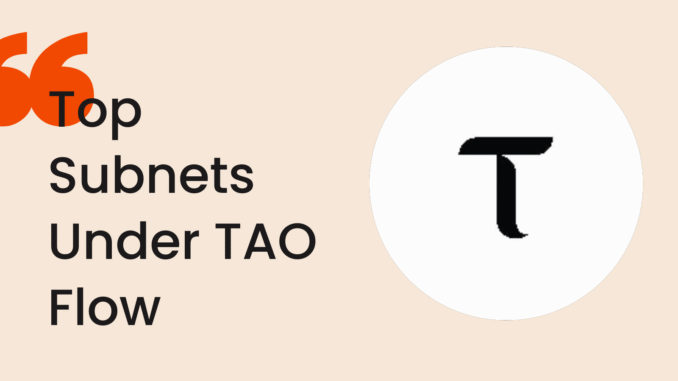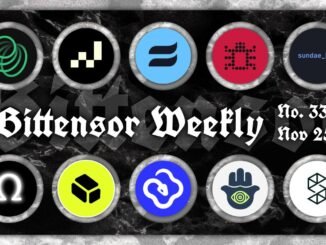
By: James Kooltek
Bittensor is entering a new era of emissions — one driven not by price momentum, but by real, sustained demand for TAO.
With the rollout of the TAO Flow Injections mechanism, emissions will soon follow actual liquidity behavior, rewarding subnets that attract persistent inflows, deep pools, and genuine utility.
This shift could completely reshape the leaderboard of who earns TAO and who fades away.
Understanding the TAO Flow Injection Rule
Under the old rule, TAO emissions were distributed based on price-weighted subnet shares — meaning the higher your alpha token price, the more emissions you received. That favored speculative spikes and short-term pumps.
The new rule changes everything.
Instead of price, emissions will be allocated based on an exponentially weighted moving average (EMA) of net TAO flow — calculated as:
buys − sells, averaged per block.
In simpler terms: Subnets that attract a steady stream of TAO buyers will dominate emissions.
What the New Model Rewards
1. Persistent Net Inflow
The key metric is the EMA of net flow, not just volume. Hot money fades fast, but steady inflows build a lasting emissions share.
Repeat buyers and recurring usage will matter far more than short-term speculation.
2. Liquidity and Throughput
Deep pools and low slippage mean healthier flow. The smoother the trading and the more TAO can move through a subnet without price shocks, the stronger its positive EMA.
3. Real External Demand
The ultimate winners will be subnets that convert real-world or external on-chain activity into TAO inflow.
Every compute job, API call, prediction fee, or storage payment that ends with TAO → ALPHA buy pressure counts.
That’s the most sustainable emissions engine of all.
4. Moderate ADR (Alpha Distribution Ratio)
When ADRs run too high, forced liquidations can drag subnet prices and emissions down. Stable ADRs suggest a healthy, balanced flow between injections and redemptions — a sign of a subnet that can thrive long-term.
Likely Top Performers in the Flow-Based Era
While everything depends on future flow dynamics, several subnets are already showing the right mix of volume, liquidity, and utility. Here’s the first bracket of likely frontrunners under the TAO Flow regime 👇
SN64 – Chutes
Serverless AI compute
One of today’s highest-emission subnets with deep liquidity and consistent trading volume. Chutes powers inference infrastructure across the network, meaning real compute demand continuously drives TAO → ALPHA buys.
Core advantage: Active user base and cross-subnet integrations (Affine, Lium) sustain repeat inflows.
SN35 – 0xMarkets
On-chain perpetuals with AI-driven liquidity
Perps are one of crypto’s biggest fee engines — and 0xMarkets has designed its system to capture that flow. LPs earn both trading fees and emissions; liquidations trigger automatic buybacks and burns of SN35 tokens.
Core advantage: Real volume translates directly into subnet revenue and TAO inflow — a strong feedback loop.
SN62 – Ridges
Code-generation & CI agents
Recently launched Ridges v1 saw massive 24-hour DEX volume and a rapidly growing pool size. Continuous dev-agent usage and testing mean active TAO cycling through their subnet.
Core advantage: Real developer adoption = sustainable buy pressure.
SN4 – Targon
Inference + verification layer
Targon benefits from the growing demand for inference compute. Its deep liquidity and steady throughput should give it a stable, positive EMA once flow-based rewards kick in.
Core advantage: Reliable throughput, strong alignment with compute demand.
SN56 – Gradients
Training and AutoML subnet
Currently mid-tier in emissions, but poised for an upgrade if user-driven training jobs ramp.
A rise in actual AI workloads directly increases TAO inflows.
Core advantage: Real-world training tasks have compounding flow effects over time.
SN51 – Lium
GPU rental & compute marketplace
A strong contender thanks to real external demand. As GPU renters pay for compute in TAO, each transaction reinforces subnet liquidity and buy pressure.
Core advantage: Transparent economics + trustless CVM-based compute with consistent TAO conversion.
SN120 – Affine
Infrastructure layer that composes other subnets
Affine validators push models directly into Chutes, creating a circular flow of TAO → ALPHA → TAO. This composability amplifies flow consistency and emissions potential.
Core advantage: Self-reinforcing linkage with SN64 ensures recurring activity.
SN41 – Sportstensor
Sports prediction & data layer
With strong 24-hour volumes and partnerships that feed external sports data into prediction markets, SportsTensor has a real engine for organic TAO demand.
Core advantage: External prediction fees and volume-linked activity ensure sustained net inflows.
Final Thoughts
The Flow Injection model marks a new phase for Bittensor — one that values use over hype, flow over price, and utility over speculation.
Projects that generate genuine TAO demand through computational services, trading systems, or real-world AI use cases will climb rapidly in the emissions table.




Be the first to comment